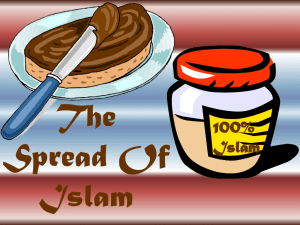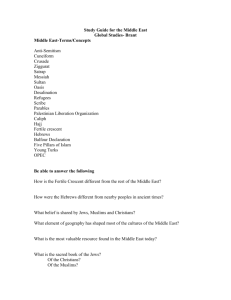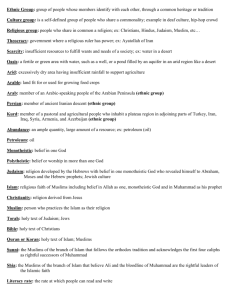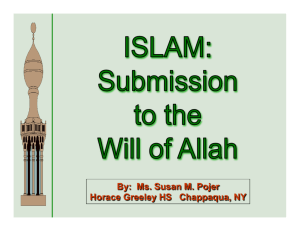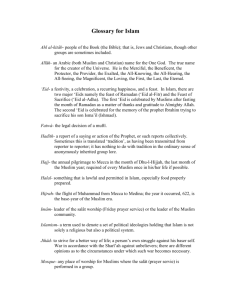Byzantine and Muslim Civilizations
advertisement
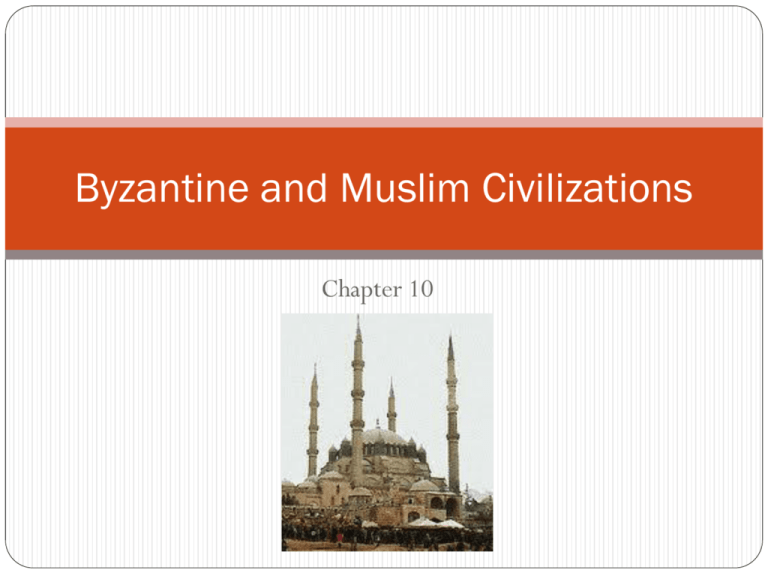
Byzantine and Muslim Civilizations Chapter 10 Do Now: Quote Analysis “I would rather let the crime of the guilty go unpunished than punish the innocent.” -Justinian 1-2 sentences each: What does this quote mean? Do you agree with it? Do Now: Picture Analysis Answer in 2+ sentences each: What do you notice about the location of this city? Describe the buildings that stand out in this picture. Do you think the domed buildings are modern or historic? Why? Why do you think the location of this city is important? Chapter 1: The Byzantine Empire Constantinople at a Crossroads Constantinople – the new capital of the Byzantine Empire Christians (Byzantines) and Muslims (Arabs or Turks) often fought over Constantinople In 330, Roman emperor Constantine moved the capital of the Roman Empire from Rome to Byzantium Renamed Constantinople Now known as Istanbul (in Turkey) Constantine and His Capital The Roman Empire continued to rule in Constantinople from 330 until the end of the empire in 476 Christians who lived there were called Byzantines (even though the city’s name was changed from Byzantium) Constantinople was a center of trade – it was the crossroads from Europe to Asia It had large markets, forums (public squares), paved roads, cathedrals, and circuses (the major circus was called the Hippodrome) Population: 500,000 Why all the fighting? Constantinople was close to the land where Jesus was born and lived (Judaea) so the Christians wanted it It was also close to the Arabian Peninsula, home of the Muslims Constantinople Judaea Arabian Peninsula Plus, Constantinople was a FANTASTIC trading port! If you control Constantinople, you control a lot of money and commerce (another word for trade and exchange of money). Why was the location so perfect for trading? Trading Constantinople was built at a crossroads of sea and land trading routes It is located on the Bosporus, which is a strait (a narrow channel) that connects the Black Sea and the Sea of Marmara It also connects to the Mediterranean Sea by way of the Aegean Sea Europe and Asia meet at the Bosporus The Byzantines grew rich by taxing the trade that went through Constantinople Constantinople was known as the “Crossroads of Europe and Asia” The Middle Ages When Rome fell, the Middle Ages began Middle Ages – the period from the fall of the Roman Empire (476) until 1500 (when the Renaissance started) Medieval – a term referring to anything during the Middle Ages The Roman Empire may have fallen, but a new empire continued in Constantinople: the Byzantine Empire The Age of Justinian Justinian – the first great Byzantine emperor Ruled from 527-565 Justinian’s Code – An organized collection and explanation of laws that was used by the Byzantine Empire Justinian used many ancient Roman laws to shape his law code This code became the basis for most modern European legal systems Byzantine culture borrowed culture from the ancient Greeks and Romans Justinian also reclaimed much of the land that had been taken from the Roman Empire, including parts of North Africa, Italy, and Spain The Empire’s Later Years Byzantine Christians practiced Christianity differently than the rest of Europe They did not follow the pope, the leader of the Catholic church The Byzantine Christian Church used Greek, but the Roman Catholic Church used Latin in written copies of the Bible The Byzantine Empire outlawed the use of praying to a painting or sculpture of saints or other religious figures, saying that doing so violated God’s commandments, but Pope Leo II disagreed Because the two sides disputed about so many different issues, it led to a schism, or a split, in the Christian church, in 1054 They split into the Roman Catholic Church in the west and the Eastern Orthodox Church in the east Despite all the fighting in the church, the Byzantine Empire became wealthier and more successful The Fall of Constantinople Christians and Muslims both lived in Constantinople, and there was constant fighting between both sides Turks (Muslims from inland parts of Asia Minor – where the country name “Turkey” came from) took over Constantinople in 1453 and renamed it Istanbul Section 2: The Beginnings of Islam Do Now: On your Guided Notes sheet, write: What do you see in this picture? What do you think is going on? The Arabian Peninsula Islam formed in Arabia Mecca – a busy trading center in Arabia that became the center of the Muslim world Islam started among a group of people called Bedouins who lived in Arabia They were nomads – people who have no permanent home and move from place to place They moved in caravans – large traveling groups Muhammad Islam was started by the Prophet Muhammad – a Bedouin nomad, in 610 According to Islam, God sent an angel to make Muhammad his messenger God gave messages to Muhammad to share, and these teachings formed Islam People who accepted these teachings became a Muslim Muslims traveled to Mecca (in Saudi Arabia) to worship at the Kaa’ba (an ancient shrine, or sacred place) Medina, north of Mecca, also became an important center for Islam Muslim Belief God is called Allah, which is Arabic for “God” Muslims pray five times a day At certain times of the day, all Muslims stop what they are doing to pray Muslims worship at a mosque – a Muslim house of worship The Five Pillars of Islam Five Pillars of Islam express basic Islamic belief 1. Declaration of Faith: Muslims believe that there is only one God and Muhammad is God’s messenger 2. Prayer: Muslims must pray five times each day 3. Almsgiving: Muslims must give alms, or money, to the poor 4. Fasting: Muslims must fast during daylight during the month of Ramadan 5. Pilgrimage: Muslims must make at least one pilgrimage to Mecca in their lives, if they are able Quran – the holy book of Islam (like the Bible is to Christians) Contains messages revealed by God to Muhammad Quran teaches that men and women are equals Gave women more rights, more protection under the law, and more opportunities for education than ever before in Arabia Muslims also experienced a schism, based on who would lead the Muslims Shi’ites Smaller group, believe that the Muslim ruler should be a descendent of Muhammad Sunnis Larger group (85%), believe that the leader of the Muslims did not have to be a descendent of Muhammad. They believed a group of Muslims should work together to lead Similarities to Christianity and Judaism Muslims worship one god, just like Christians and Jews Muslims believe that Allah is the same god that Christians and Jews believe in, who is referred to in the Bible (“Allah” simply means “God” in Arabic) All three have a holy book Muslims have the Qu’ran Christians have the Bible (Old and New Testament) Jews have the Tanakh (the Old Testament in the Bible) Muslims believe in Jesus, but they believe he was an important prophet, or messenger of God, but not the son of God Section 3: Muslim Civilization The Spread of Islam Islam spread to North Africa, Spain, Persia, and China Arab merchants helped to spread Islam Many of the Christians in Constantinople converted Muslims tolerated other religions and allowed them to practice their faith, even after they were conquered The Golden Age Golden Age of Islam: 800-1100 Arab world was very wealthy Caliphs (a Muslim religious leader) helped develop a wealthy empire Baghdad (in Iraq) became the Muslim center of trade Advances in math and science Al-Khwarizmi – a Muslim mathematician who helped invent algebra Omar Khayyam – Muslim astronomer, mathematician, and poet Literature Sufis were Muslims who believed they could draw close to God through prayer, fasting, and a simple life Sufis used poetry and writing to spread their beliefs The Ottoman Empire Muslims from Asia Minor (Turkey) called Ottomans took over Constantinople in 1453 Renamed the city Istanbul Sultan – a Muslim political ruler Sultan ruled over the entire empire Ottomans allowed Christians and Jews to practice their religion Video Clips on Islam http://www.history.com/videos/principles-of-islam Reflection on Islam: The Muslim World Today To conclude our unit on Islam, please write one good paragraph that includes three things that you learned during our study of Islam. How do you think that this knowledge will benefit you in the future? Reflect and Write Why do you think many of the Muslim countries are located in the Middle East (near Arabia) and North Africa? Think about where Islam originated. Worldwide Population There are 1.6 billion Muslims around the world (23-25% of the world’s population!) Where do you think that ranks in size among world religions? Christianity is the only religion that is bigger (about 2 billion) Islam is the world’s fastest growing religion From 1900-1970, the Muslim population grew from 200 million to 550 million From 1970 to now, the Muslim population grew from 550 million to 1.6 BILLION!! Countries with Largest Muslim Population Indonesia – 204 million (88%) Pakistan – 178 million (96%) India – 177 million (14%) Bangladesh – 148 million (90%) Egypt – 80 million (94%) Some countries are made up of 99% Muslims! These countries include Morocco, Afghanistan, Iran, Tunisia, and Yemen. Shi’ites and Sunnis Sunnis – they originally believed that the leader of the Muslims should be elected fairly because of their qualifications and readiness for the job Sunnis make up about 85% of the Muslim population Shia Muslims – they originally believed that the leaders of the Muslims should always be a direct descendant of Muhammad Shi’ites make up 15% of the Muslim population Famous Mosques The El-Mursi Abul Abbas Mosque – in Egypt Grand Mosque of Kuwait – in Kuwait What do you notice about the architecture of these mosques? Although not all Muslims speak Arabic as their native language, most at least know some of the Qur’an in Arabic. This is “Allah” written in Arabic – as you can see, it is much different from English! Arabic is written from right to left. Islam in the USA The state with the highest population of Muslims is California. There are 260,000 Muslims who live there. 120,000 Muslims live right here in NJ!

